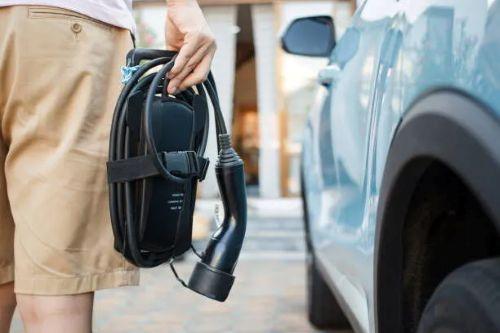Notifications

7 minutes, 39 seconds
-24 Views 0 Comments 0 Likes 0 Reviews

Topper Company is a professional EV charger manufacturer in China, providing dependable electric vehicle charging stations and comprehensive solutions.
Electric vehicles (EVs) are revolutionizing modern transportation, offering a cleaner and more sustainable way to travel. Yet, for many new EV owners, one pressing question remains: How do I keep my vehicle charged when I’m away from home or far from a public charging station?
The answer increasingly lies in portable EV chargers—compact, user-friendly devices that provide charging freedom wherever a compatible power outlet is available. Whether you're at home, on a road trip, or parked at a remote cabin, a portable charger ensures that you're never out of options.
In this comprehensive guide, we’ll explain how portable EV chargers work, the benefits they offer, how to use them effectively, and what to consider when choosing one for your needs.
A portable EV charger is a mobile charging unit that lets you power up your EV’s battery without relying solely on fixed home or public charging stations. Unlike wall-mounted chargers that require permanent installation, portable chargers are designed for ease of transport and plug-and-play operation.
Typical components include:
Control Box – The smart unit that regulates and monitors the charging process.
Power Cable – Plugs into a standard electrical outlet (120V or 240V).
Connector Plug – Attaches securely to your EV’s charging port (typically a J1772 connector in North America; Tesla drivers use an adapter).
These chargers are compact enough to store in your trunk, making them a handy solution for charging on the go.
Portable EV chargers function similarly to home chargers by pulling electricity from a power outlet and delivering it to your EV's battery safely.
Here’s how it works:
Connect to Power: Plug the charger into a compatible 120V (Level 1) or 240V (Level 2) outlet.
Regulate Power: The control box ensures the voltage and current are suitable for your vehicle.
Secure Plug-In: Connect the charger to your EV’s charging port.
Monitor Charging: Many chargers include LED indicators, screens, or apps to track charging status and progress.
The key advantage? Mobility. You’re no longer limited to specific charging locations.
Charge anywhere there’s a power outlet—home, work, campsites, or remote cabins.
Eliminates reliance on public networks, especially useful in rural or underdeveloped areas.
Generally cheaper than installing a permanent Level 2 home charging station.
Just plug in and charge—no electrician needed (as long as an appropriate outlet is available).
Easy to transport and store; many models come with carrying cases.
Useful during unexpected low-battery situations when a public charger is unavailable.
| Level | Voltage | Speed | Use Case |
|---|---|---|---|
| Level 1 | 120V (household outlet) | 3–5 miles/hour | Backup, overnight home charging |
| Level 2 | 240V (dryer/RV outlet) | 12–30 miles/hour | Daily charging, travel use |
| Level 3 (DC Fast Charging) | Direct Current, commercial stations only | 80% in 20–60 mins | Long-distance travel |
🔌 Note: Portable EV chargers are typically Level 1 or Level 2. DC fast charging is not available in portable form due to infrastructure requirements.
Know Your Outlets: Identify 120V or 240V outlets you’ll have access to.
Check EV Compatibility: Ensure your vehicle supports the charger's output power.
Set Correct Amperage: Match the amperage to your outlet’s limits to avoid tripping circuits.
Use Extension Cords Wisely: Only use heavy-duty, outdoor-rated cords if absolutely necessary.
Monitor with Apps or Displays: Stay informed of charging progress and any errors.
Store Properly: Keep the unit dry, coiled, and stored in a protective case to prolong its life.
Look for chargers offering adjustable amperage (commonly 16A to 40A) to suit different vehicles and outlets.
Ensure compatibility with NEMA 5-15 (120V) or NEMA 14-50 (240V) plugs, depending on your use case.
Longer cables offer flexibility but may be bulkier to carry.
If charging outdoors, choose a weatherproof unit rated for rain, dust, and temperature extremes.
Look for UL or CE certifications and features like overcurrent protection, overheating protection, and ground fault detection.
Apartment/Condo Residents: Without access to permanent chargers, portable units offer a practical alternative.
Business EV Fleets: Great for topping off vehicles between shifts or at temporary sites.
Road Trippers: Ideal for remote travel or stays in cabins, RV parks, or national parks.
Emergency Preparedness: Can pair with generators during outages or disasters.
As EV adoption grows, portable chargers are evolving rapidly. Many now offer:
Smart App Control
Charging Scheduling
Real-Time Diagnostics
Dynamic Amperage Adjustments
These features will make them even more practical for daily use and support the growing need for flexible, reliable, and decentralized EV charging solutions.
A portable EV charger is more than a backup—it's a smart investment that enhances convenience, travel freedom, and charging reliability. Whether you're commuting in the city, exploring the outdoors, or simply want a versatile solution without installing fixed infrastructure, portable chargers give you the confidence to go electric—without limits.
Empower your journey. Charge anywhere. Drive everywhere.Know more about Google SEO Directory
China EV Chargers EV Charger Manufacturer EV Charging Solutions

